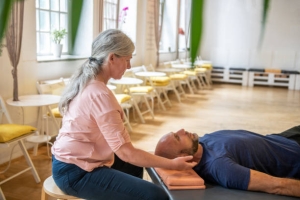Somatic Therapy
Somatic therapy organizes my clinical practice.

Somatic therapy is not a technique or specified set of techniques. It is a comprehensive approach to therapy, an orientation to the whole person that integrates mind, body and emotions at its core. I teach and practice somatic therapy.
Somatics is a general term that refers to the broadest set of practices that integrate the awareness of our internal sensations, body structure and movement, emotions, thoughts and identities into a unified approach to personal transformation. Going beyond the simple reference to soma, somatics share the common notion that our bodies and minds are integrated into a body-mind system. Somatic practitioners work from the perspective that while we live in our bodies, our bodies exist in contexts that are larger, relational and influential.
And context is consequential. The contexts of our lives have immediate and substantial impact on the way we experience ourselves as people. That is to say, the historical, cultural, social, familial and relational contexts condition the way we experience ourselves and influence how we interpret the world around us. Add the social forces of gender, race and class and we identify the primary influences on the development of our personal identities. The weight of these factors takes its toll on our body-mind system.
By making the larger contextual factors explicit and proper objects to consider, somatics fosters not only the potential for personal transformation, but also for social transformation. Not by setting a political agenda, but by recognizing that the larger body politic affects the personal politics of everyday life. And that can be felt in the body and reflected on through the mind. To be successful, psychotherapy must address the implicit information held in the body along with the beliefs that reinforce it.
Body psychotherapy approaches both the implicit messages from the body and explicit beliefs by bringing the body back into the psychotherapeutic process. Body psychotherapists share the fundamental assumption that the body-mind system forms the whole human being and that by observing the body in the present moment, we can gain access to the lifetime of experience it expresses but cannot articulate with words. Relational body psychotherapy goes further to suggest that the relational field during psychotherapy sessions shifts the dynamics from two bodies interacting with each other to a single energetic body formed through the interaction between the two. This relational dynamic provides a comprehensive approach to exploring the body-mind system.
Bottom-Up Repair of Early Trauma
Traditional psychotherapy focused on talking about thoughts and feelings and, for the most part, ignored body-based experience. We now understand that trauma affects both mind and body and contemporary approaches have adapted to work with both. We speak of working top-down and bottom-up. Top-down refers to placing attention of thoughts, emotions, sensations, and then the deeper aspects of neurophysiology and energetics. Working bottom-up refers to starting with attention to the energetics and neurophysiology and then to sensations, emotions and thoughts. Successful trauma repair uses both bottom-up and top-down practices to address the complexities of identity and the disorganized physiology.
The short video below provides an excellent description of the consequences of early developmental trauma on brain development and some of what must happen to repair the early insults and develop new habits and perspectives.
Views: 394